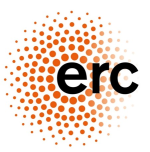
The biggest challenge in NMR spectroscopy is its inherent low sensitivity. This is due to the low nuclear magnetic moment of many of the elements in the periodic table as well as limited abundance of many of the NMR active isotopes (nuclei with non zero nuclear spin). Poor sensitivity often prevents detailed characterization of materials and poses an even greater challenge when it comes to detecting interfaces.
Dynamic Nuclear Polarization (DNP) is an approach for transferring the high polarization of electron spins to surrounding coupled nuclear spins by microwave irradiation. DNP can result in 10,000 increase in NMR sensitivity making materials that were practically invisible for NMR – visible!
Typically, DNP is achieved by introducing stable organic radicals into the sample. Our group is working on alternative approaches where the polarization agents, the unpaired electrons, are within the sample – either by doping inorganic solids with paramagnetic metal ions, utilizing conduction electrons or defects in the material. This endogenous approach is particularly attractive for the research of functional (such as electrodes/solid electrolytes) or complex (such as heterogenous organic/inorganic composites) materials as it circumvents possible reactivity with the exogenous radicals and offers a mean to probe the bulk or buried interfaces within the sample. Furthermore, new polarization agents such as high spin metal ions raise many intriguing question to explore regarding the mechanism of DNP in solids.
In our research we address these mechanistic questions using quantum mechanics and numerical simulations of the spin dynamics as well as through materials science tools – developing model systems that provide unique insight into the DNP process.
This unique approach allows us to unravel the underlying physical principles of DNP as well as to develop new tools to study the structure and composition of fascinating materials systems, from batteries to biominerals.
Some reviews (by us and other groups) on DNP for solid state NMR:
- Dynamic Nuclear Polarization Surface Enhanced NMR Spectroscopy
Aaron J. Rossini, Alexandre Zagdoun, Moreno Lelli, Anne Lesage, Christophe Copéret, Lyndon Emsley, Acc. Chem. Res., 2013, 46 (9), pp 1942–1951 - Dynamic Nuclear Polarization in battery materials, Haber & Leskes in Solid state NMR (2022)
- Dynamic Nuclear Polarization Solid-State NMR Spectroscopy for Materials Research, Moroz & Leskes in Annual Review of Material Research (2022)
- Dynamic nuclear polarization in inorganic solids from paramagnetic metal ion dopants, Jardon-Alvarez & Leskes; chapter in Comprehensive Inorganic Chemistry III (Elsevier)
Our work:
- Surface Sensitive NMR Detection of the SEI Layer on Reduced Graphene Oxide
Michal Leskes, Gunwoo Kim, Tao Liu, Alison Michan, Fabien Aussenac, Patrick Dorffer, Subhradip Paul and Clare Grey J. Phys. Chem. Lett. (2017) - Paramagnetic Metal‐Ion Dopants as Polarization Agents for Dynamic Nuclear Polarization NMR Spectroscopy in Inorganic Solids
Tanmoy Chakrabarty, Nir Goldin, Akiva Feintuch, Lothar Houben, Michal Leskes ChemPhysChem (2018) - Endogenous Dynamic Nuclear Polarization for Natural Abundance O-17 and Lithium NMR in the Bulk of Inorganic Solids
Tamar Wolf, Sandeep Kumar, Harishchandra Singh, Tanmoy Chakrabarty, Fabien Aussenac, Anatoly I. Frenkel, Dan Thomas Major, Michal Leskes J. Am. Chem. Soc. (2019) - The effects of sample conductivity on the efficacy of dynamic nuclear polarization for sensitivity enhancement in solid state NMR spectroscopy
Asya Svirinovsky-Arbeli, Dina Rosenberg, Daniel Krotkov, Ran Damari, K. Kundu, Akiva Feintuch, Lothar Houben, Sharly Fleischer, Michal Leskes Solid state Magn. Reson. (2019) - Enabling Natural Abundance 17O Solid-State NMR by Direct Polarization from Paramagnetic Metal Ions, Daniel Jardón-Álvarez, Guy Reuveni, Adi Harchol, Michal Leskes, J. Chem. Phys. Lett. (2020)
- Endogenous dynamic nuclear polarization for sensitivity enhancement in solid-state NMR of electrode materials, Adi Harchol, Guy Reuveni, Vitalii Ri, Brijith Thomas, Raanan Carmieli, Rolfe H Herber, Chunjoong Kim, Michal Leskes, J. Phys. Chem. C (2020)


